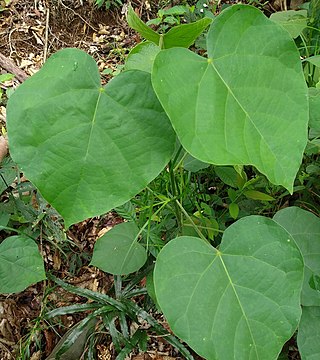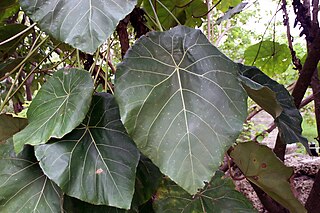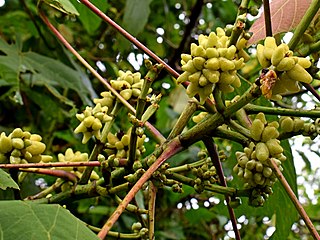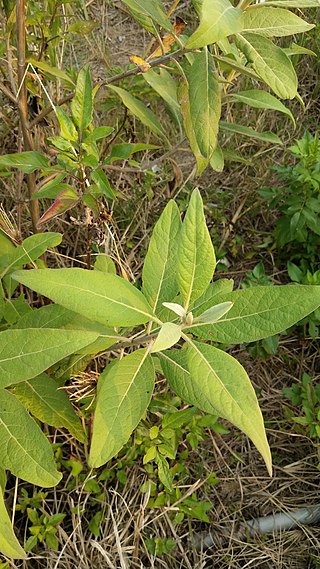
Anolis carolinensis or green anole is a tree-dwelling species of anole lizard native to the southeastern United States and introduced to islands in the Pacific and Caribbean. A small to medium-sized lizard, the green anole is a trunk-crown ecomorph and can change its color to several shades from brown to green.

Mallotus is a genus of the spurge family Euphorbiaceae first described as a genus in 1790. Two species are found in tropical Africa and Madagascar. All the other species are found in East Asia, the Indian Subcontinent, Southeast Asia, eastern Australia, and certain islands of the western Pacific. The genus has about 150 species of dioecious trees or shrubs.

Macaranga is a large genus of Old World tropical trees of the family Euphorbiaceae and the only genus in the subtribe Macaranginae. Native to Africa, Australasia, Asia and various islands of the Indian and Pacific Oceans, the genus comprises over 300 different species. It was first described as a genus in 1806, based on specimens collected on the Island of Mauritius.

Cleidion is a plant genus of the family Euphorbiaceae, first described in 1826. It is found in tropical and subtropical regions in Asia, Africa, Australia, Latin America, and various islands of the Pacific and Indian Oceans.

Endospermum is a genus of plants, under the family Euphorbiaceae and the monotypic subtribe Endosperminae first described as a genus in 1861 They are dioecious, rarely monoecious trees. It is native to E + S + SE Asia, Papuasia, Queensland, and certain islands of the W Pacific.

The chuck-will's-widow is a nocturnal bird of the nightjar family Caprimulgidae. It is mostly found in the southeastern United States near swamps, rocky uplands, and pine woods. It migrates to the West Indies, Central America, and northwestern South America.
Macaranga attenuata is a species of plant in the family Euphorbiaceae. It is endemic to the Society Islands of French Polynesia, where it is found on Moorea, Raiatea, and Tahiti.
Macaranga bicolor is a species of plant in the family Euphorbiaceae. It is endemic to the Philippines.
Macaranga caudatifolia is a species of plant in the family Euphorbiaceae. It is endemic to the Philippines.

Macaranga grandifolia is a species of flowering plant in the family Euphorbiaceae. Common names for this plant include nasturtium tree, parasol leaf tree and bingabing. It is endemic to the Philippines and has been widely cultivated in Hawaii as a tropical ornamental. This plant has become very popular garden ornamental in many parts of the tropics for the extraordinary grandiose leaves, which are rounded-ovate in shape, with prominent, reddish veins and the stem attached towards the center of the leaf blade. The flowers are pinkish red and the males are held in coral-like, congested inflorescences. Twine made from the bark and the wood was used for fishing spears. The leaves were used to wrap food. Birds eat the ripe fruit.
Macaranga huahineensis is a species of plant in the family Euphorbiaceae. It is a tree endemic to the island of Huahine in the Society Islands of French Polynesia.
Macaranga mauritiana is a species of plant in the family Euphorbiaceae. It is endemic to Mauritius.
Macaranga raivavaeensis is a species of plant in the family Euphorbiaceae. It is endemic the islands of Raivavae and Rimatara in the Tubuai Islands of French Polynesia.
Macaranga taitensis is a species of plant in the family Euphorbiaceae. It is a shrub or tree endemic to the island of Tahiti, in the Society Islands of French Polynesia.
Macaranga venosa is a species of plant in the family Euphorbiaceae. It is endemic to the Society Islands of French Polynesia, where it grows on the islands of Raiatea, Tahaa, and Tahiti.

Macaranga tanarius is a plant found in South East Asia, Thailand, Papua New Guinea, South China, Taiwan, and eastern Australia. It is commonly seen as a pioneer species in disturbed rainforest areas. Easily recognised for the round veiny leaves. In Australia it naturally occurs from the Richmond River, New South Wales to Cooktown in tropical Queensland.
Macaranga indica is a heliophilous evergreen plant native to South and Southeast Asia and China. A crimson colored resin called "macaranga gum" is obtained from this plant. Many parts of the plant are used for ayurvedic medicine in India and Sri Lanka.

Macaranga triloba is a species of plant in the family Euphorbiaceae. It is native to the tropical forests of southeastern Asia. It is a pioneer species, colonising recently cleared or burnt areas of the forest.

The Carolines tropical moist forests is a tropical and subtropical moist broadleaf forests ecoregion in Micronesia. It includes the central and eastern Caroline Islands in the Federated States of Micronesia.

Pluchea carolinensis is a plant in the genus Pluchea.











